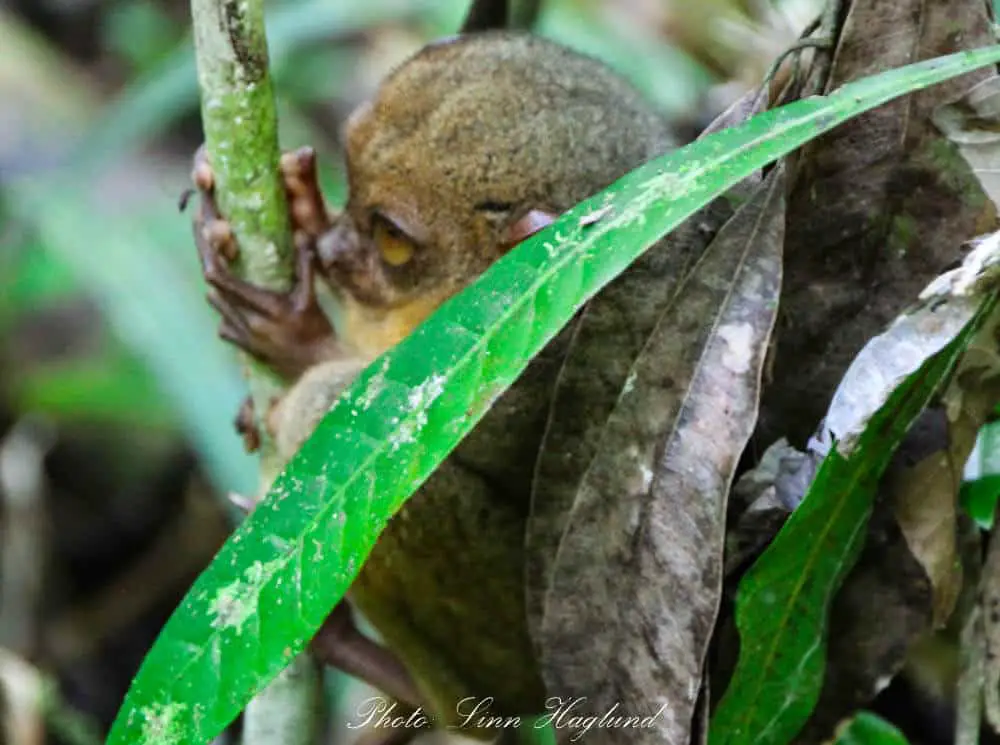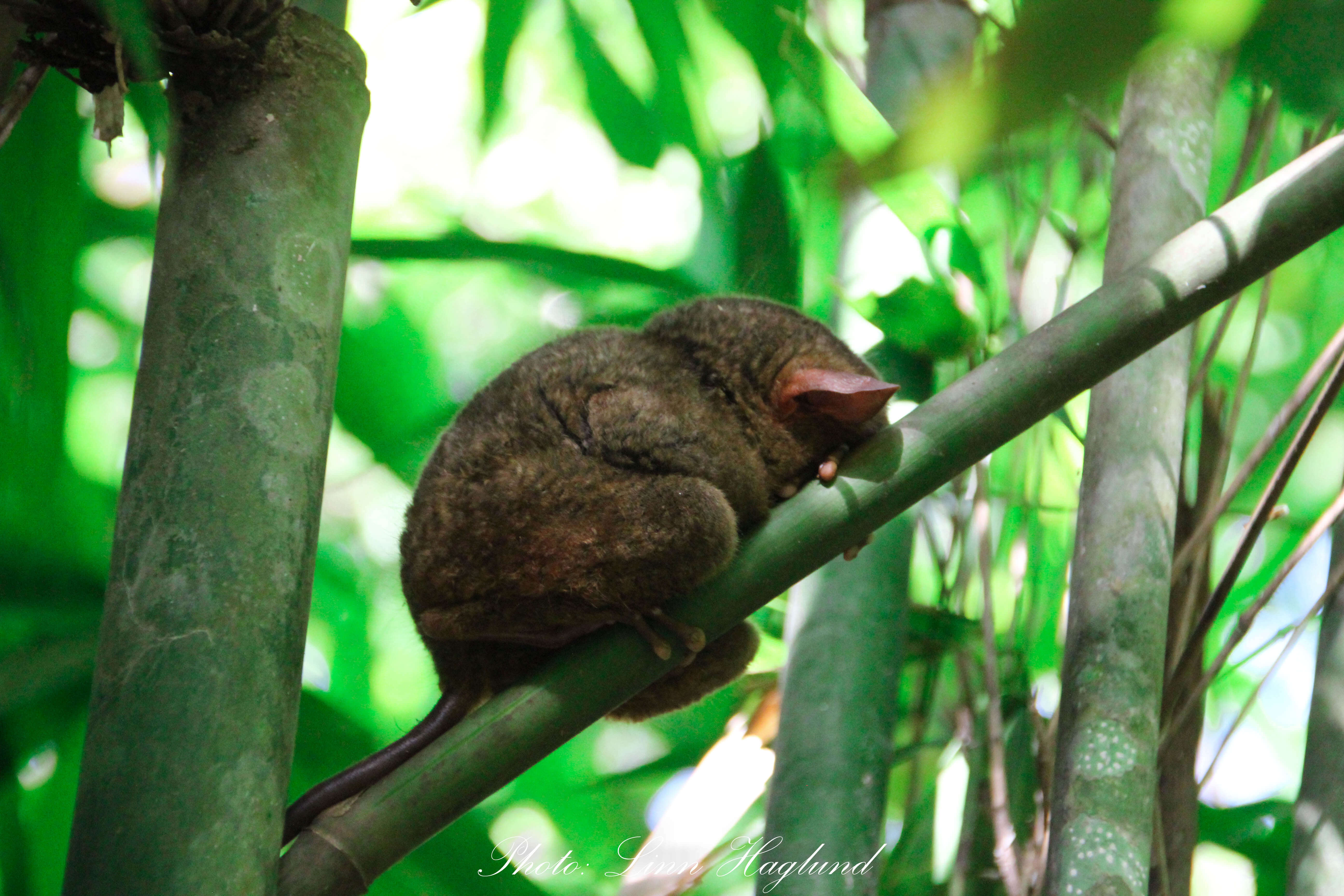I was walking in silence behind our guide, trying not to make any noise along the tiny path. We were surrounded by tight bamboo trees searching for the tiniest primate on earth, the Philippine Tarsier.
Suddenly, the guide stopped. I nearly ran into him as I was looking into the trees, but managed to stop just in time not to create a mess. He turned around and whispered as he pointed to a tree beside the trail, and there it was; a tiny oh-so-cute little Tarsier. As we started whispering the tiny creature opened its huge eyes and looked at us. The Tarsier is nocturnal and sleeps during the day, therefore we didn’t want to wake him up.
Disclosure: This post may contain affiliate links. That means that if you make a purchase through one of those links, I will get a small commission at no extra cost to you. If you have any questions about these services or products, feel free to ask me.
Plant trees to create habitat for animals from the convenience of your home
The Philippine Tarsier
The Philippine Tarsier is one of the tiniest primates on earth. They are only 85 to 160 mm long, which is pretty small. They are mainly found in the Philippine islands of Bohol, Leyte, Samar, and Mindanao. During many years they were kept in captivity as pets. Still today, locals keep them in cages at their homes to hook tourists and offer them to pet a Tarsier or take a selfie with one.

Our driver proudly announced that he used to have a Tarsier himself. His kids used to love playing with it, and he often brought tourists home to take photos with the tiny animal. The friendly man was sad to let us know that his pet had died, so he wasn’t able to take us.
Never pet a Tarsier or put it in a cage
Why did our driver’s pet tarsier die? We got the answer at the Philippine Tarsier Sanctuary in Corella, Bohol. Tarsiers commit suicide when they are held in captivity. The tiny creature also gets traumatized by loud noise and touching. Therefore, it is important to stay in silence while observing the threatened species and never try to touch one.
Just like you wouldn´t leave your dog in a cage all day and night without walking it for the rest of its life, you shouldn´t put a Tarsier in a cage. Your dog would become depressed, aggressive and unreliable, just like a human in a solitary prison cell. The Tarsier, just like the human in the solitary cell, will become so depressed that it gets to the point that it prefers to take its own life instead of keeping living like that.
You might also like: Unethical animal tourism and what to do in stead
The Philippine Tarsier Sanctuary

The Philippine Tarsier Sanctuary has a lot of important and educational information about the primate. There are also other places to see Tarsiers on the island, but they are more interested in making money than preserving the species. That means they also let tourists touch them and take photos with them. The chances you might be able to pet a Tarsier is large, though this is a major threat to the species.
The sanctuary works together with the Philippine Tarsier Foundation to protect the animals. Their main goal is to protect the species and its habitat from extinction. The sanctuary has a forest area large enough for the Tarsiers to move freely at the same time as they are protected against any predators. The Philippine Tarsiers main predators are humans, snakes, and cats.
RELATED: Why you should never hold a sloth
But is the Philippine Tarsier Sanctuary really that ethical?
Recently, I got a concerned message from a reader. She showed me a series of comments on Tripadvisor from visitors to the sanctuary.
Those comments were not as positive as I would like. Comments addressed the following issues:
- High noise levels which clearly disturbed the animals and kept them awake
- Tourists walking off the path to get photos closer
- Guides letting the tourists be noisy and disturb the animals instead of telling them off.
- Guides making the tarsiers change position so that they looked better on the photos.
- The tarsiers were all strategically sitting by the path where the tourists walked
I want to talk a bit more about the last point. When I visited, I was questioning the same thing, though there were hardly any other tourists there when I visited, so I didn’t experience any of the other concerns.
One visitor stated in her comment that she had visited the sanctuary two years in a row and the animals were sitting exactly at the same place both years.
Another visitor claimed she had talked to a few volunteers before her visit, who told her they place the animals close to the path each morning. They told her the exact placement where they would be before the visit, and she found them right there when she arrived. Her description of where the tarsiers sat, seemed extremely similar to where I saw the little primates on my visit.
Would I visit again? Probably not.
Some facts about the Tarsier
The Philippine Tarsier can become 20-25 years old in the wild. However, in captivity, they rarely last more than 10-12 years, but they often die within a day or two in unhealthy captivity. The animal needs loads of bamboo to live well. The bamboo leaves provide a dual purpose for the primate. First of all, the leaves catch the rainwater so that the Tarsier can cool down. Secondly, the Tarsier hates rain and therefore uses the leaves to get shelter from the raindrops.
The Tarsier eats mainly insects and hunt by jumping at their prey. They need to eat one-tenth of their body weight to stay healthy. For humans, it is hard to arrange this amount of living insects when feeding Tarsiers. As a result, they are often malnourished and sick in captivity.

Reflections
As we walked along the trail we saw three tarsiers in total. We didn´t disturb them on their branch, we hardly made a noise to wake them up, but the first one we saw did open its eyes. The experience was truly magical, but after being aware of other visitors’ experiences I wouldn’t visit the sanctuary again or recommend it at the time being. The sanctuary made it clear why you should never pet a Tarsier or why you should not keep one as a pet. But are they being strict enough when it comes to noise levels and disruptions?
These were the questions I asked myself after my visit:
How is it that all three Tarsiers we saw were all along the path? Was it a coincidence? Do they have different paths that they clear in the morning according to where they find the animals sleeping? Or do they move the animals close to the track so that they will be easy to spot for visitors?
Now, I might have gotten a confirmation of my doubts.
Book your flight to the Philippines now!
Do you have any experience with the Philippine Tarsier? Please share your experiences and thoughts in the comments.
Check out the best things to do in Bohol.

What a thought provoking post! I think it is so important that we as travellers spread the word of responsible travel and make sure we’re all doing what we can to make the world a better place – for everyone and everything in it. Thanks for sharing.
Hi Sheree! Thank you for your supportive words! I agree that it is important to spread the knowledge we acquire during our travels. In that way, we will contribute to a better world little by little, step by step.
Thanks for sharing this post Linn. I’d never heard of a tarsier, and it is sad that these tiny little creatures suffer due to the tourism industry. Thanks for spreading the message about ethical tourism in connection with wildlife. Such a cute pic of the little sleeping tarsier too:)
Thank you so much, Shelley! I appreciate that you see the importance of ethical tourism choices in connection with wildlife. Unfortunately, it is overseen by so many because of the lack of knowledge. I know, the Tarsiers are super-cute! It is so easy to understand why they have been kept captive for so many years, but I really hope good education on the animal turns this around.
Such cute animals! Thank you for sharing a post like this to remind people to respect beautiful creatures such as this one <3
Thank you for reading, Lauren!
Thank you for talking about this. I think it is very important that these beautiful animals are respected. I found many places tell me that it’s not a good idea to keep a tarsier in captivity, none of them however told me why. Thx for writing this <3
Thank you! I’m so glad you found this helpful!:)